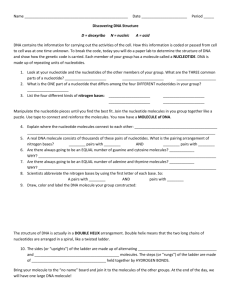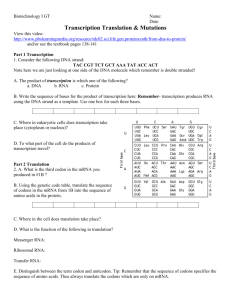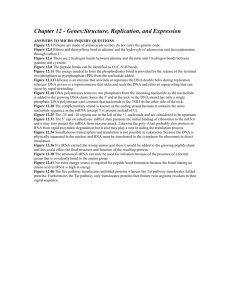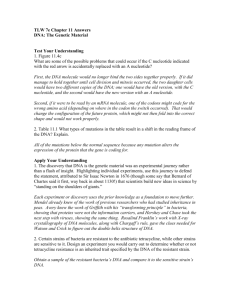Some thoughts about being stuck in a mental rut More than once I've
advertisement
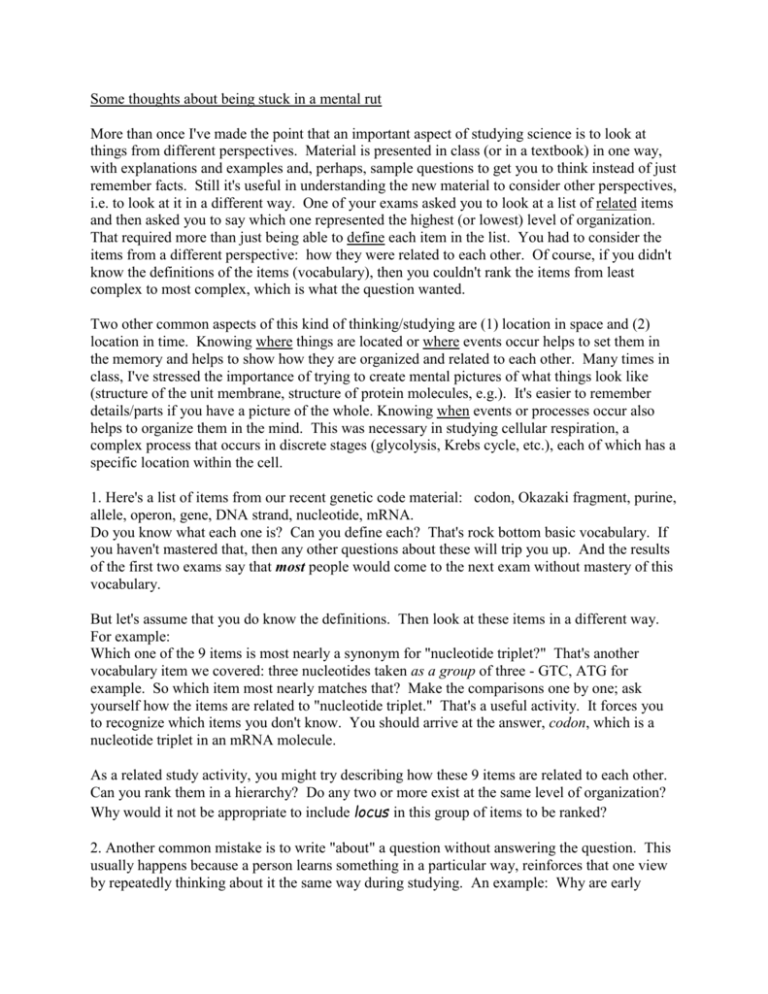
Some thoughts about being stuck in a mental rut More than once I've made the point that an important aspect of studying science is to look at things from different perspectives. Material is presented in class (or in a textbook) in one way, with explanations and examples and, perhaps, sample questions to get you to think instead of just remember facts. Still it's useful in understanding the new material to consider other perspectives, i.e. to look at it in a different way. One of your exams asked you to look at a list of related items and then asked you to say which one represented the highest (or lowest) level of organization. That required more than just being able to define each item in the list. You had to consider the items from a different perspective: how they were related to each other. Of course, if you didn't know the definitions of the items (vocabulary), then you couldn't rank the items from least complex to most complex, which is what the question wanted. Two other common aspects of this kind of thinking/studying are (1) location in space and (2) location in time. Knowing where things are located or where events occur helps to set them in the memory and helps to show how they are organized and related to each other. Many times in class, I've stressed the importance of trying to create mental pictures of what things look like (structure of the unit membrane, structure of protein molecules, e.g.). It's easier to remember details/parts if you have a picture of the whole. Knowing when events or processes occur also helps to organize them in the mind. This was necessary in studying cellular respiration, a complex process that occurs in discrete stages (glycolysis, Krebs cycle, etc.), each of which has a specific location within the cell. 1. Here's a list of items from our recent genetic code material: codon, Okazaki fragment, purine, allele, operon, gene, DNA strand, nucleotide, mRNA. Do you know what each one is? Can you define each? That's rock bottom basic vocabulary. If you haven't mastered that, then any other questions about these will trip you up. And the results of the first two exams say that most people would come to the next exam without mastery of this vocabulary. But let's assume that you do know the definitions. Then look at these items in a different way. For example: Which one of the 9 items is most nearly a synonym for "nucleotide triplet?" That's another vocabulary item we covered: three nucleotides taken as a group of three - GTC, ATG for example. So which item most nearly matches that? Make the comparisons one by one; ask yourself how the items are related to "nucleotide triplet." That's a useful activity. It forces you to recognize which items you don't know. You should arrive at the answer, codon, which is a nucleotide triplet in an mRNA molecule. As a related study activity, you might try describing how these 9 items are related to each other. Can you rank them in a hierarchy? Do any two or more exist at the same level of organization? Why would it not be appropriate to include locus in this group of items to be ranked? 2. Another common mistake is to write "about" a question without answering the question. This usually happens because a person learns something in a particular way, reinforces that one view by repeatedly thinking about it the same way during studying. An example: Why are early insertion point mutations almost always harmful? Of course, we must know what that is (vocabulary again!) before we can answer the question. The typical answer is something like the following. "An early insertion point mutation is harmful because it changes the reading frame, causing the whole sequence to be messed up." First problem: "messed up" is so vague in this sentence that I don't know what the writer means by that. Second: "whole sequence" of what? This answer doesn't even reveal whether the writer knows that the issue here is an altered gene. Third: Even if I assumed that the writer is referring to the nucleotide sequence of a gene, saying that the reading frame is changed by the mutation doesn't explain why the change is harmful. Answer: The early insertion means that most of the gene's anticodon sequence will be altered. In turn that means that the amino acid sequence of the protein produced will be radically changed, which means that the protein produced will not function. Since all protein types perform necessary functions, the failure of that function to be performed will harm that cell type, and ultimately the whole organism. 3. A related study tool is making lists, to help organize material and as a way to check whether some item is missing. Several times in class I've used short lists to stress a relationship among some group of items (families of molecules, components of a unit membrane, levels of protein structure, components of a "nucleotide," etc.). However, many people don't use this device effectively. It's probable that everyone could correctly list the sequence of stages in meiosis. That's basic memorization. But many people won't connect that list to the obvious list of "what important event(s) happens in each stage of meiosis." So, points are lost for (i) not knowing when homologues separate, (ii) when crossing over occurs, (iii) what happens in anaphase II, (iv) whether chromosomes are duplicated in one of the stages, (v) when nondisjunction occurs, etc. 4. As we know, point mutations occur in the DNA sequence. Those changes are reflected in the corresponding mRNA molecules. Look at the table of codons in the textbook and then consider the following three examples of mutations. Case 1: UCA is mutated to UCG Case 2: UCA is mutated to UGA Case 3: UCA is mutated to UUA Explain the potential consequences of these three mutations. That would mean to consider, e.g.: (i) Is each harmful or beneficial? (ii) equally so? (iii) Does it matter if one is early or late? (iv) Can you give a rationale by which one of these mutations might be either harmless or lethal in the same location? 5. Sam and Dave are studying DNA replication as shown in the drawing below; they found this drawing on-line. They agree (correctly) that one copy of DNA polymerase attaches to each original DNA strand and synthesizes a complementary strand. Sam says that the two enzyme molecules move in the same direction along the template strands, but Dave says that the two enzyme molecules move in opposite directions along the template strands. In an effort to resolve their disagreement, they search the web for an animation of the process. Sure enough, when they find one, it is obvious that the DNA polymerase molecules are moving in opposite directions along the two template strands. So, Dave was right. But Sam was right too. How can they both be right?


